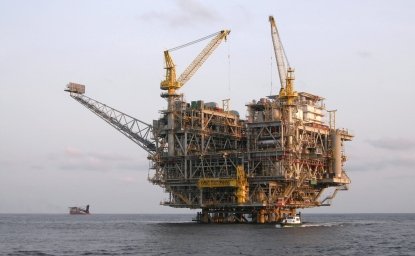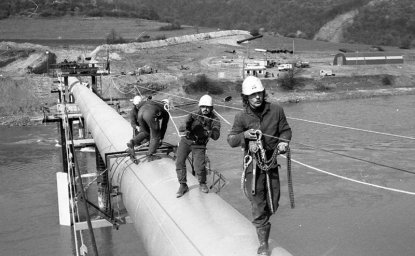It is becoming clear that Saudi Arabia’s de facto ruler Crown Prince Mohammed bin Salman has no intention of ending his kingdom’s long-decried “addiction to oil.” He even plans to expand its production capacity immediately by at least a million barrels a day in a show of defiance for calls upon oil-producers to diversify away from fossil fuels and myriad predictions the oil era is fast coming to an end. His plan to increase Saudi capacity to over 13 million barrels a day is based on what appears to be a fantastical forecast for the near total collapse of oil production in the United States and Russia, by the end of this decade for the former and by the next for the latter. Saudi Arabia, he argues, must be ready to step up and fill a coming oil supply shortage.
His calculation comes in the face of the current upsurge in the development of renewable sources of energy relying on wind, solar and hydrogen and multiple studies such as a recent International Monetary Fund one, warning of “a strong and sustained declining trend in the global oil demand.” It urged the Gulf Arab producers in particular to accelerate and widen their reforms aimed at diversifying their economies in preparation for a post-oil future coming “sooner rather than later.”
The Paris-based International Energy Agency has just issued a report on ambitious proposals by the European Union and Biden administration to reach net-zero carbon emissions by 2050, stating that to make that possible “there is no need for investment in new fossil fuel supply.” Indeed, worldwide oil production will have to be drastically cut from 90 million barrels per day in 2020 to 24 million barrels. The Saudi oil energy minister, Prince Abdul bin Salman, the crown prince’s brother, quickly derided the report as “the sequel of the La La Land movie.”
While demand in the West may be declining, MBS is calculating that it will only increase in the East, mainly in China and India, throughout this decade and then hold steady for decades to come.
The Saudi crown prince (MBS) is not only categorically rejecting this vision of a post-oil world. He has apparently also abandoned his own declared goal of kicking the kingdom’s addiction to oil—one of the key objectives of his Vision 2030 announced just five years ago. Instead, his immediate fixation, as reflected in his April interview on Saudi national television, has become the three-way competition for market share among Saudi Arabia, Russia and the United States, currently the world’s three top producers. While demand in the West may be declining, MBS is calculating that it will only increase in the East, mainly in China and India, throughout this decade and then hold steady for decades to come.
His justification for increasing Saudi production probably also reflects his conviction of additional competition for market share from mostly fellow Arab members of the Organization for Petroleum Exporting Countries (OPEC) laying similar plans to tap their reserves as fast as possible in light of the West’s accelerating switch from oil and gas to renewable energy sources. It’s not only Saudi Arabia, but Iraq, the United Arab Emirates, Qatar and even Bahrain are launching projects to boost their oil production, or gas in the case of Qatar, already the world’s leading exporter of liquefied natural gas. (Saudi Arabia is the world’s top oil exporter.)
The case of Saudi Arabia is most striking because of the radical change in thinking by the crown prince, who has also become the kingdom’s economic czar. In 2016, he was full of optimism that the kingdom could kick its addiction to oil and rather quickly, too. “I think by 2020, if oil stops we can survive,” he said introducing the Vision 2030 plan to overcome the national addiction. “We need it, but I think in 2020 we can live without oil.” He assured Saudis his vision was “not a dream, it’s a reality that will come true.” His vision has proven indeed to be a dream. In 2020, the giant Saudi state oil company, Saudi Aramco, provided altogether $110 billion to the government coffers in dividends, royalties and income taxes, despite seeing its profits cut by more than half to $49 billion due to the pandemic-provoked worldwide recession. The government’s budget that year was set at $272 billion, and it had to turn to issuing bonds at home and abroad to cover most of the $79 billion deficit. In 2019, oil sales had provided the government with $159 billion in revenues.
It has also been cutting food, gas and electricity subsidies and forcing thousands of members of the royal family to begin paying for their electricity, water and domestic air fares.
The scramble to find alternative sources of revenue has mostly focused on squeezing money out of Saudis. There is no income tax in the kingdom, however, the government has instituted a value-added tax on most sales, first set at five percent and hence raised to 15 percent in 2020. It has also been cutting food, gas and electricity subsidies and forcing thousands of members of the royal family to begin paying for their electricity, water and domestic air fares. It has also imposed an annual residence tax on the kingdom’s eight to ten million foreign workers and family members.
MBS seems convinced that both the short and long-term answer to Saudi Arabia’s ever worsening financial crunch is to pump more oil. In his April interview, he took direct issue with the consensus of Western energy analysts predicting an accelerated switch from fossil fuels to renewables. The real issue, he asserted, will not be falling demand but a supply shortage mainly because of his envisaged massive plummet in U.S. and Russian production. “The U.S. for example will not be an oil-producing country in 10 years,” he said, modifying that prediction slightly by adding that instead of 10 million barrels a day it will “barely produce” two million barrels by then. This prediction stands in sharp contrast to a February report from the U.S. Energy Information Administration (EIA) which forecast that U.S. crude production is more likely to increase to between 13 million and 14 million barrels a day by 2030 and stay at that level until 2050. U.S. production could remain “at record-high levels for the next 30 years,” at least if prices hold up. Crude oil production averaged 11.3 million barrels a day in 2020, down almost one million barrels from the previous year due to the pandemic-induced recession.
Nonetheless, MBS holds that oil supply will decline much faster than oil demand and Saudi Arabia must be ready to 'increase its production to cover the need for oil.'
In the case of Russia, the crown prince claimed its production would drop from 11 million barrels a day to one million barrels “more or less” in 20 years. A recent Russian parliament study, however, projects its oil production will peak at nearly 14 million barrels by 2029 followed by a decline of only about one quarter by 2035. Nonetheless, MBS holds that oil supply will decline much faster than oil demand and Saudi Arabia must be ready to “increase its production to cover the need for oil.” Part of his projection foresees an increased need for oil in the kingdom itself, which he estimated will reach three million barrels daily to meet “huge opportunities” in its own expanding petrochemical and manufacturing industries.
The state oil company Aramco has already begun expanding its offshore Zuluf field, one of its biggest, raising production there from 800,000 barrels a day to 1.4 million. It is also investing $18 billion to add 550,000 barrels daily from two other offshore deposits at Marjan and Berri. Altogether, these projects would add more than one million barrels to its known production capability of 12.3 million barrels. This was the amount it jumped to from 9.6 million barrels daily in the spring of 2020 to force Russian and American companies into cutting their production by flooding the market with cheap oil.
NEOM will also be the site for the kingdom’s first production of “green hydrogen,” so called because the energy needed to produce it will rely solely on solar and wind.
Saudi Arabia is also going into the renewable energy business, including both solar and wind. But the rationale for this now seems mostly to make available more oil for export. For example, MBS’s new fantastical city, NEOM, scheduled to cost $500 billion to construct, is projected to depend solely on wind and solar power for an envisaged population of one million. NEOM will also be the site for the kingdom’s first production of “green hydrogen,” so called because the energy needed to produce it will rely solely on solar and wind.
MBS has found Saudi Arabia increasingly in need of cooperation with Russia, partly to deal with competition from the United States which, last year exported more than three million barrels a day, despite the pandemic-induced economic recession. It has not been easy because Russia has been pressing to increase its production, while Saudi Arabia has fought to cut OPEC’s. It even unilaterally took one million barrels a day off the market in January. All this is about to change. On June 2, OPEC voted to restore the two million barrels a day it had earlier cut by July, and Saudi Arabia has indicated it intends to restore its one million barrel reduction. Additional supply will clearly be forthcoming to fuel the post-Covid economic revival.
Whatever Saudi-Russian differences on oil policy, MBS seems to agree wholeheartedly on one point with the head of Russia’s parliamentary energy committee. He was quoted recently as saying, “Everything that can be produced should be produced while there is still demand to sell it.”
The views expressed in these articles are those of the author and do not reflect an official position of the Wilson Center.
Author

Former Washington Post Middle East Correspondent

Middle East Program
The Wilson Center’s Middle East Program serves as a crucial resource for the policymaking community and beyond, providing analyses and research that helps inform US foreign policymaking, stimulates public debate, and expands knowledge about issues in the wider Middle East and North Africa (MENA) region. Read more

Explore More
Browse Insights & Analysis
La esencia de la infraestructura global: perspectivas del líder de la industria Matt Harris

Debunking the Patient Capital Myth: The Reality of China’s Resource-Backed Lending Practices


